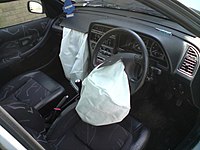
Photo from wikipedia
Seated occupants may experience discomfort or meet with injuries if the vertical vibration frequency lies in the range of 4–20 Hz. To examine the effect of vibration on seated occupants, it… Click to show full abstract
Seated occupants may experience discomfort or meet with injuries if the vertical vibration frequency lies in the range of 4–20 Hz. To examine the effect of vibration on seated occupants, it is necessary to develop a biomechanical model that can precisely predict the biodynamic responses (seat to head transmissibility, driving point mechanical impedance, and apparent mass) of a real human. In the past, none of the studies segregated the human body mass into bones and muscles mass that have distinct mechanical properties. In this article, the work is carried out in four steps: first, development of a novel 8- dofs biomechanical model by considering both bone and muscle masses; second, development of all the feasible configurations of 8- dofs model followed by identification and optimization of model parameters with firefly algorithm (FA); third, calibration of all the feasible models as per the standards of biodynamics and selection of best four models; and fourth, comparison of biodynamic responses of best four models with experimental responses and past developed models. The goodness of fit of a seat to head transmissibility, driving point mechanical impedance, and apparent mass for the best model is obtained 0.986, 0.976, and 0.956, respectively.
Journal Title: Proceedings of the Institution of Mechanical Engineers, Part D: Journal of Automobile Engineering
Year Published: 2021
Link to full text (if available)
Share on Social Media: Sign Up to like & get
recommendations!